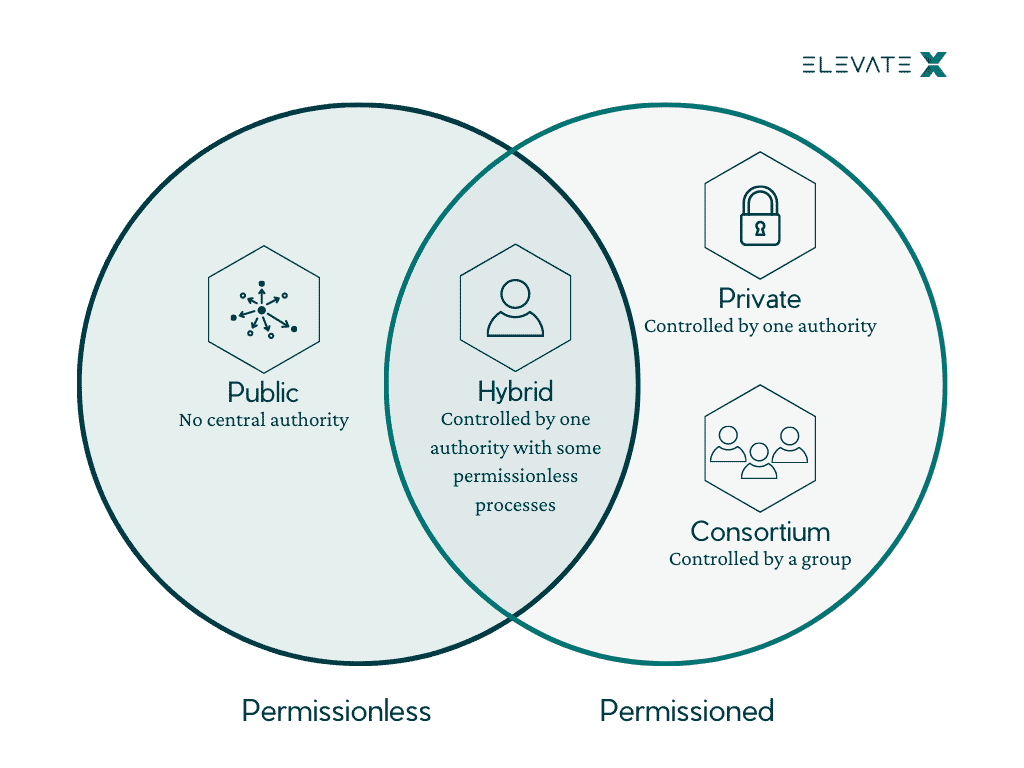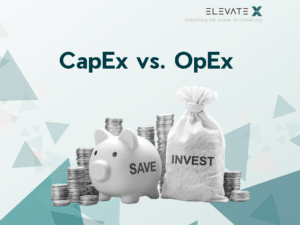Wait, what? Now there’re even different blockchain types? Yes, there are.
Since the vast majority merely understands Bitcoin under the term Blockchain, it is of even greater importance to know the different Blockchain types and which type fits which use case. What are the different types of blockchain, how do they differ, and what are the possible advantages and disadvantages?
Blockchain Basics
Blockchain is currently a dominant tech topic. We have included blockchain and its benefits in our ranking of the most important tech trends.
Are you new to blockchain? Then we recommend our Beginner’s Guide for an easy introduction to the topic. Here we explain many things such as how blockchain works, corresponding application areas such as smart contracts, cybersecurity or cryptocurrencies, and much more. We are happy to introduce you to the Blockchain.
Basically, we have to distinguish between four different Blockchain structures: Public, Private, Consortium and Hybrid. In addition, a distinction must be made between permissionless and permissioned. Permissionless blockchains allow any user to participate in the network without verification or the like, i.e. to become a node of this network. In the opposite case, the permission-required blockchain, users can be restricted upon joining or subsequently becoming part of the network. Also, one is anonymous in the permission-free blockchain, whereas this is usually not the case in the permission-required blockchain.
Permissionless vs. Permissioned Blockchains
Looking at security, permissionless blockchains tend to be more secure. This is because there are many nodes that validate transactions and the entire database. Collusion is nearly impossible in this regard, making the blockchain nearly tamper-proof. The fewer nodes there are in a blockchain, the easier it is for malicious actors to collude. Therefore, private blockchain administrators must ensure that the nodes adding and verifying blocks are highly trustworthy. In addition, it tends to be easier for third parties to join the system; this can also be beneficial.
One negative aspect of permissionless blockchains is the long transaction times that occur due to the large number of nodes and the size of the transactions, as well as the high energy consumption. Since access to the network or rights in the network are limited, there are fewer nodes, resulting in less processing time per transaction. This can make permission-based blockchains more efficient.

The 4 Types of Blockchain Types
Public Blockchains
Public blockchains can be recognized by their decentralized structure and the fact that they are permission-free by nature, meaning that anyone is allowed to join. All nodes have the same right to access the blockchain, create new data blocks and validate them. Bitcoin and Ethereum are the best-known public blockchains. Joining is possible for anyone in this case, also each node has the same number of votes.
Advantages:
+ Thanks to the decentralized structure, malicious actors have a hard time gaining control of the system. The network is trusted through the process of proof-of-work or proof-of-stake.
+ The ease of access compared to private blockchains allows for greater propagation of the system. This benefits the system itself as well as the users – keyword here: network effect. This allows the network to be applied more broadly and is at the same time more secure, as it is more difficult to hack.
+ Since the public blockchain has a high level of transparency, fake transactions cannot be displayed, or existing ones can be hidden.
For an excellent explanation of Proof-of-Work and Proof-of-Stake, check out this YouTube video. Moving from Proof-of-Work to Proof-of-Stake not only requires less energy, but it is also more secure and can increase TPS.
By the way, you can find a general comparison of advantages and disadvantages of blockchain here on our blog.
Disadvantages:
– One disadvantage is the low TPS (transactions per second) on public blockchains. A comparison between public blockchains such as Bitcoin or Ethereum and the VISA network shows the difference: while Bitcoin and Ethereum each come to 7 and 15 TPS, respectively, the VISA network is at 24,000 TPS.
– The slow processing rates of the public blockchains also lead to lower scalability. This is because network growth hurts the network’s ability to process transactions. More and more transactions are piling up and cannot be processed. Proof-of-stake or other algorithmic changes can be used to increase transactions/second, something the Ethereum network in particular is currently striving to do.
– Last, the high energy consumption can be seen as a negative. While public blockchains are incredibly secure, at the same time the process of proof-of-work is very energy consuming. This is not only a concern from an environmental perspective, but also from an economic perspective. A very descriptive breakdown of Bitcoin’s energy consumption with appropriate examples was published by the New York Times last year.
What Is Off-Chaining?
In the public ledger of the blockchain, transactions are only considered valid once they are stored there and authenticated and validated by a defined number of participants. In off-chain transactions, however, an app uses the functions of the public blockchain but stores the “secret” data outside the public area. The actual transaction takes place outside the blockchain and can be processed either by a temporary “third party” or by defining smart contracts.
This approach is used by companies like PayPal to carry out transactions in real-time without having to go through the longer process required in traditional blockchain transactions.
Unlike a private blockchain, not all participants are known in a public blockchain. Participants can anonymously participate in governance decisions, join DAOs, or receive rewards for staking tokens by participating in proof-of-stake or other consensus mechanisms. The consensus mechanism ensures that each participant behaves according to the underlying protocol and adheres to the rules of the blockchain.
Consensus In Public Blockchains
In a public blockchain, there is no single person or group responsible for control. Instead, decision-making and verification of transactions are done through various consensus mechanisms such as proof-of-work or proof-of-stake.
Consensus plays an important role in the blockchain as it ensures that all transactions are valid and all participants have access to all data. Only valid transactions are stored in the blockchain, and their validity is determined by the consensus.
For example, the proof-of-work algorithm (PoW) is used in the Bitcoin blockchain, and other blockchains such as Ethereum now also use PoW as well as other technologies. In creating a consensus and confirming a transaction in the blockchain, PoW works by solving a computational puzzle. This requires high computational and resource power from the nodes, resulting in increased power and hardware costs.
PoS is used in Ethereum 2.0 as a consensus mechanism, among others. Unlike PoW, PoS is expected to cause significantly less power and resource costs, as nodes do not require high computational power.
In the PoS mechanism, the performance of a node is not used to determine the consensus, but rather a random selection combined with weighting decides which node can solve the computational puzzle. In order for certain nodes to validate transactions in the blockchain, they must have a certain amount of tokens or coins.
Private Blockchains
In contrast to public blockchains, private blockchains are characterized by a centralized or only partially decentralized character. This means that they can be completely controlled by a single organization. This central organization determines who is allowed to be a node and who is not. In addition, the rights of each node may differ – which node has which rights to perform actions is decided by the central organization.
Advantages:
+ Usually faster validation times, since fewer nodes. The problems that affect the Ethereum network, among others, do not occur here, or hardly at all. TPS speeds in the four- to six-digit range are possible with private blockchains.
+ Stronger control over the system, companies in particular benefit from this. For example, if you want to be able to identify people individually or control certain things, a private network is advantageous. Rights can be assigned individually, so you retain control over the network. This also allows the network to be scaled almost arbitrarily – another advantage.
Disadvantages:
– The biggest disadvantage of a private blockchain is the possible lack of trust in it. There is usually no open ledger here, so the security and legitimacy of each user is not independently assured.
– The risk of a security breach is also higher in the case of private blockchains. In some cases, a single node can determine the rights or validation of other nodes’ transactions. This harbors risks, especially in terms of human error or malicious behavior.
Consortium Blockchains
This is a so-called semi-decentralized network in which not just one, but at least two organizations manage the blockchain network. In terms of advantages and disadvantages, you also have a mix of both networks here. On the one hand, there is less security because transactions are again validated by only a few nodes, but on the other hand, the system can scale better and the TPS are higher. Semi-decentralized networks are used by banks or government agencies, for example.
Hybrid Blockchains
The hybrid approach consists of a combination of a private and a public component. Here, the characteristics of both types of blockchains are used. Basically, there are two options when building hybrid blockchains:
Private, permission-based system
Public, permission-free system.
In hybrid systems, individual users can control whether and how access rights are granted, i.e., who gets access to the data stored in the blockchain.
A key advantage of the hybrid network is flexibility. Users can connect several public blockchains with a private blockchain. This allows the advantages of the two types of networks to be used in a targeted manner. A transaction in a private network of a hybrid blockchain is usually verified within this network. However, it can also be given to a public blockchain, whereby it is verified here. Since more nodes are involved here for verification, the security and transparency of the network increases.
Why Do We Need Different Blockchain Types?
The goals of a blockchain are the execution of transactions and the exchange of information via a secure network. Nevertheless, the requirements for the network differ, which is why different blockchains are necessary. Factors that cause differences in networks:
- Control over the network
- Need for public validation
- Level of TPS
- Trustworthiness and security
A practical example is represented by the requirements for blockchain and DLT technology on the part of the Ethereum network and the network of a bank. While Ethereum wants to include the largest possible number of users across the planet in its network, a bank may have different plans. A bank may aim for a restricted network where only the authorized members of the bank have access to confidential and sensitive information. By controlling permissions and access, the bank can grant access to its network only to trusted individuals and define the scope of its private blockchain geographically. These freedoms do not exist with a public Blockchain.
In this respect, it is important not to exclude one type of Blockchain per se or to consider it “bad”. Each type has its advantages and disadvantages, as well as certain application areas in which it is the champion. It is important to understand when which type of blockchain can and should be used to provide the best possible and ideally error-free solutions.
ElevateX is there for you and supports you from the beginning to implement your strategies and plans. Whether you need personalized support for your project or IT experts, head over here to get started.
What Are Smart Contracts?
Smart contracts are a central application area of blockchain technology in companies and organizations. They have a significant influence on the decision for a specific type of blockchain, particularly in private or federated blockchains.
Within a blockchain, smart contracts can be developed. These are digital contracts based on computer protocols that can automate business processes. These intelligent contracts are more efficient and cost-effective than manual processes.
Smart contracts utilize the advantages of blockchain technology and are therefore particularly secure, transparent, and reliable. Although they are not currently legally binding, they could soon become legally valid due to advancing technology.
Is Blockchain The Technology Of The Future?
Blockchain technology has the potential to play an important role in the future. It enables secure and transparent recording of transactions, which can be applied in various industries such as finance, healthcare, and logistics. The decentralization of the blockchain also provides more security and trust as no central authority has control over the data. Although there are still some challenges, such as scalability and public acceptance, there are already numerous companies and organizations that are successfully utilizing the technology. Whether blockchain will be the technology of the future remains to be seen, but it is certainly a promising technology that is being further developed and can be applied in many areas.
Conclusion
Thanks to innovative developments, the question “What are the different types of blockchains?” can be answered as follows: There is a suitable blockchain type for every problem and application. Digitization has led to a growing importance of distributed ledger technologies like blockchain and has brought forth many new application possibilities.
Companies can freely decide whether they need an open or closed, permissioned or permissionless, or consortium blockchain solution. There are numerous new blockchain types with different consensus mechanisms and innovative decentralized applications that increase the acceptance of blockchain technologies.
There are already prefabricated frameworks and infrastructures, but companies also have the option of setting up their own blockchain using open-source technology or their own knowledge.








